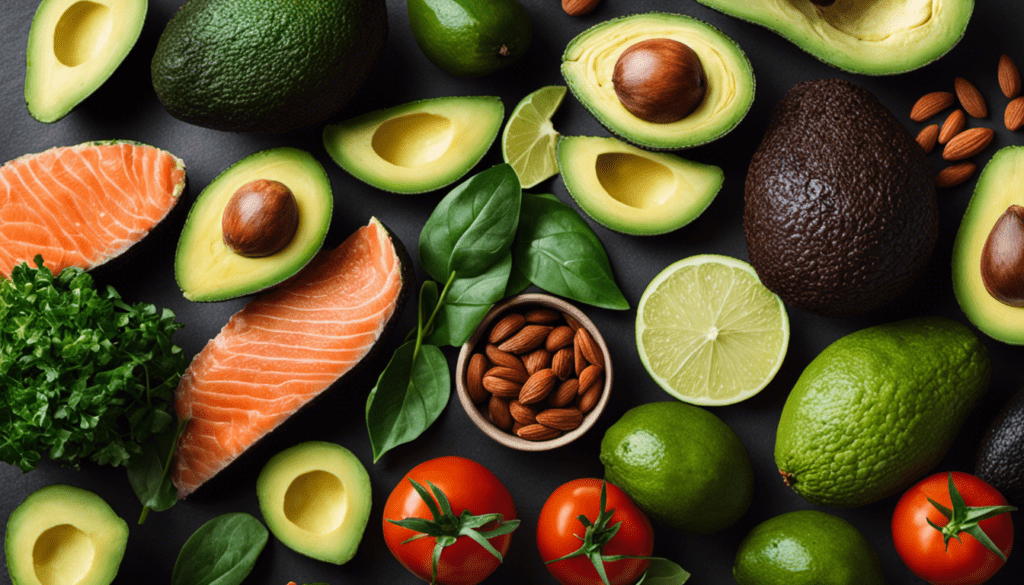Are you ready to unlock the secrets of a keto diet and embark on a journey towards a healthier you? Imagine a world where you can enjoy delicious foods while still achieving your weight loss goals. Well, it’s time to make that dream a reality. In this article, we will guide you through the process of calculating macros for a keto diet as a beginner.
Macronutrients, such as carbohydrates, proteins, and fats, play a crucial role in our overall health and well-being. By understanding the importance of these nutrients and setting the right macro ratios, you can optimize your body’s energy production and fat-burning potential.
Whether you’re aiming to shed a few pounds or simply want to improve your eating habits, tracking your macros is essential. With the help of a food diary or app, you’ll be able to keep an accurate record of your daily intake and make adjustments as needed.
So, get ready to dive into the world of keto macros and discover the path to a healthier, happier you!
Key Takeaways
- Understanding the importance of macronutrients in a keto diet
- Setting a daily calorie goal and planning meals accordingly
- Determining the ideal macronutrient ratios for a keto diet
- Tracking macros with a food diary or app for accountability and progress tracking
Understanding Macronutrients and their Importance
You’re going to love learning about macronutrients and why they play such a crucial role in your keto diet!
Counting macros for weight loss is an essential part of the process. Macronutrients, also known as ‘macros,’ are the three main components of our diet: carbohydrates, proteins, and fats. Each of these macronutrients provides a different amount of energy and serves various functions in our body.
By understanding the importance of each macro and balancing them correctly, you can optimize your weight loss journey on the keto diet.
Additionally, macro timing is another factor to consider for optimal results. Timing your intake of macronutrients strategically can help support your energy levels, muscle recovery, and overall performance.
Now that you have a grasp on the significance of macronutrients, let’s move on to setting your daily calorie goal and taking the next steps towards a successful keto diet.
Setting Your Daily Calorie Goal
Starting with a clear vision of your desired daily calorie goal sets the foundation for a successful journey towards a healthier lifestyle. Calculating your calorie deficit is crucial in achieving weight loss on a keto diet. It involves consuming fewer calories than your body needs to maintain its current weight. This deficit forces your body to use stored fat as fuel, resulting in weight loss.
To determine your calorie goal, you can use an online calculator that takes into account your age, gender, weight, height, and activity level. Once you have your daily calorie goal, you can plan your meals accordingly.
Incorporating intermittent fasting can also be beneficial on a keto diet. It involves alternating periods of eating and fasting, which can help further enhance weight loss and improve insulin sensitivity.
Next, we will discuss determining your ideal macronutrient ratios to optimize your keto diet.
Determining Your Ideal Macronutrient Ratios
Let’s dive into finding the perfect balance of macronutrients to optimize your keto journey. When it comes to determining your ideal macronutrient ratios, there are a few key factors to consider.
Calculating protein requirements: Protein is an essential macronutrient that plays a vital role in building and repairing tissues. To calculate your protein needs for a keto diet, aim for around 0.6 to 0.8 grams of protein per pound of lean body mass. This will help preserve muscle mass while promoting fat loss.
Finding keto-friendly food options: On a keto diet, it’s important to focus on low-carb, high-fat foods. Incorporate sources of healthy fats like avocados, nuts, and olive oil, while limiting your intake of carbohydrates from grains, sugary foods, and starchy vegetables. Opt for protein sources such as meat, fish, and eggs.
Transitioning into the next section about tracking your macros with a food diary or app, it’s essential to monitor your macronutrient intake to ensure you’re staying within your desired ratios.
Tracking Your Macros with a Food Diary or App
To make tracking your macronutrients easier and more enjoyable, try using a food diary or app. This allows you to effortlessly monitor your intake and stay on top of your nutritional goals.
Using a food diary or app has several benefits when it comes to tracking your macros. Firstly, it provides you with a clear picture of your daily intake, making it easier to identify any imbalances or deficiencies.
Secondly, it helps you stay accountable and motivated by allowing you to see your progress over time. Additionally, many tracking apps offer features such as barcode scanning and pre-set food entries, making it quicker and more convenient to log your meals.
When looking for a macro tracking app, consider factors such as user-friendliness, accuracy of the nutrient database, and compatibility with your devices. By using a food diary or app, you can easily keep track of your macros and make informed decisions about adjusting and fine-tuning your macros as needed.
Adjusting and Fine-Tuning Your Macros as Needed
As you fine-tune your macros, remember to listen to your body’s cues and adjust your intake accordingly. This will ensure a personalized and effective approach to achieving your nutritional goals.
When it comes to adjusting macros for different fitness levels, consider your activity level and goals. If you’re more active or looking to build muscle, increase your protein intake. Conversely, if you’re less active or trying to lose weight, lower your overall calorie intake.
Troubleshooting common macro tracking mistakes is crucial. Double-check your portion sizes, read labels carefully, and be mindful of hidden sources of carbs and fats.
Regularly reviewing and adjusting your macros will help you optimize your keto diet and stay on track towards your health and wellness goals.
Frequently Asked Questions
Are there any specific foods that should be avoided on a keto diet?
To maintain a successful keto diet, it’s important to avoid specific foods that are high in carbohydrates. These include grains, sugar, starchy vegetables, and most fruits.
Instead, focus on consuming low-carb alternatives such as leafy greens, avocados, nuts, and seeds. These options are rich in healthy fats and low in carbs, making them perfect for a keto diet.
Remember, always consult with a healthcare professional before starting any new diet for personalized advice and safety.
Can I still consume alcohol on a keto diet?
When it comes to alcohol on a keto diet, it’s important to tread carefully. While it’s not completely off-limits, alcohol can have an impact on your ketosis.
Alcohol is processed differently in the body, potentially slowing down fat burning and affecting your overall progress.
It’s best to choose low-carb options like vodka or dry wine, and consume in moderation.
Remember, the key to success on a keto diet is maintaining a state of ketosis.
How long does it typically take to reach ketosis?
To reach ketosis, it typically takes around 2-7 days, but it can vary for each person. Some tips to reach ketosis faster include reducing your carb intake to below 50 grams per day, increasing your fat intake, and staying properly hydrated.
Signs of being in ketosis include increased energy, decreased appetite, and a fruity smell to your breath. Remember to consult with a healthcare professional before starting any new diet.
Is it necessary to count net carbs or total carbs on a keto diet?
To maintain ketosis levels on a keto diet, it’s important to count net carbs instead of total carbs. Net carbs represent the total carbs minus the dietary fiber and sugar alcohols, which have minimal impact on blood sugar levels.
By focusing on net carbs, you can ensure you’re consuming the right amount to stay in ketosis.
This approach allows for a wider variety of food choices while still maintaining the desired state of ketosis.
How can I manage cravings and hunger on a keto diet?
To manage cravings and hunger on a keto diet, there are several effective techniques you can try.
First, focus on consuming foods that are high in healthy fats and protein. These can help keep you feeling full and satisfied for longer periods.
Additionally, staying hydrated and drinking plenty of water can also help curb hunger.
Another strategy is to include fiber-rich foods like vegetables and avocados in your meals. These can promote feelings of fullness.
Finally, practicing mindful eating and listening to your body’s hunger cues can help you differentiate between true hunger and cravings.
Conclusion
In conclusion, as you embark on your keto journey, understanding and calculating your macros is key to achieving success.
By setting a daily calorie goal and determining your ideal macronutrient ratios, you can ensure that your body is in a state of ketosis.
Tracking your macros with a food diary or app will help you stay on track and make necessary adjustments along the way.
Remember, Rome wasn’t built in a day, so be patient and consistent, and soon you’ll be reaping the rewards of a well-balanced keto diet.








